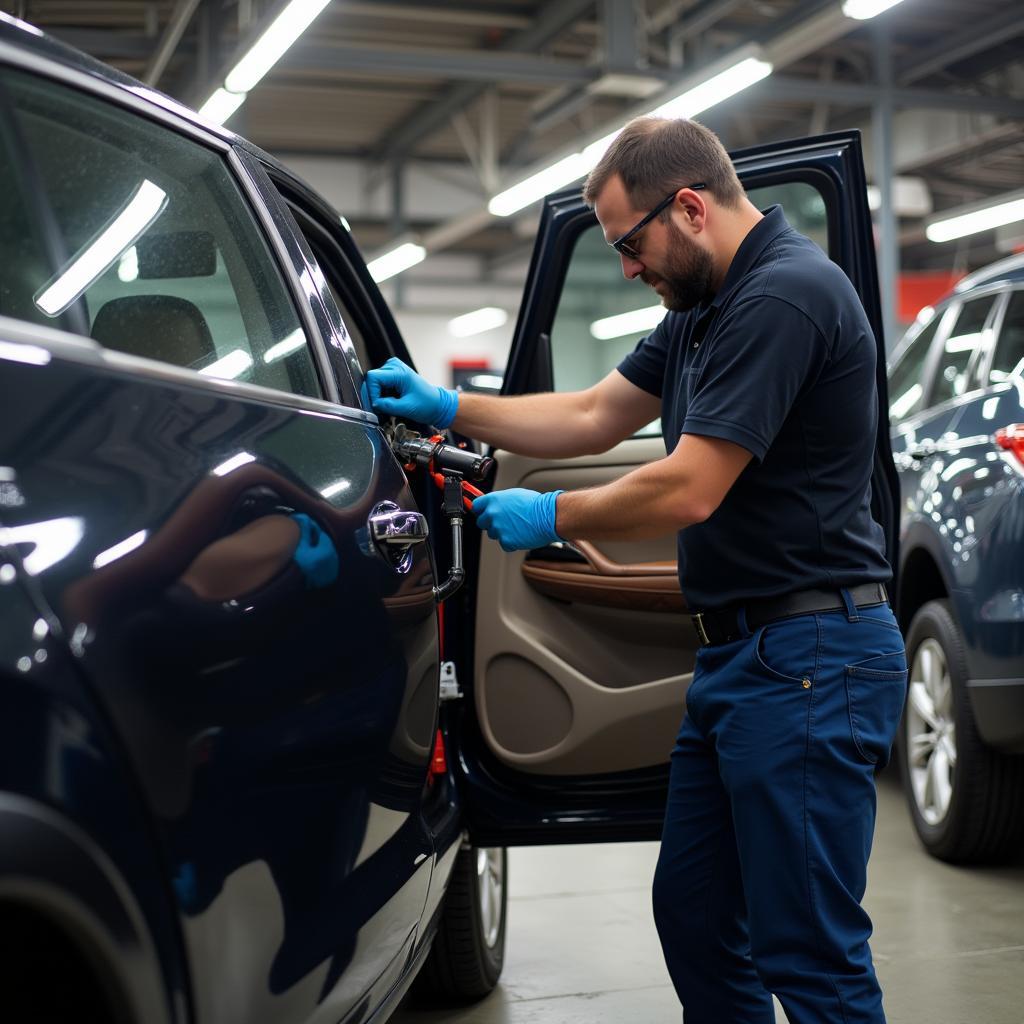Getting a dent in your car door can be frustrating, but luckily, there are ways to fix it. Whether you’re dealing with a minor ding or a more serious dent, this comprehensive guide will walk you through the different methods for repairing a dented car door.
Assessing the Damage: When DIY Isn’t Enough
Before jumping into DIY solutions, it’s important to assess the severity of the dent. While minor dents might be fixable at home, significant damage may require professional intervention. Here’s a simple breakdown:
Minor Dents:
- Shallow indentations
- Paint is not cracked or chipped
- The metal is not creased or stretched
Major Dents:
- Deep indentations
- Paint damage (cracks, chips, scratches)
- Creased or stretched metal
- Damage to underlying structures (door frame, window mechanisms)
For major dents, it’s always best to consult with a professional auto body shop. They have the expertise and equipment to restore your car door to its pre-accident condition.
DIY Dent Repair: Tackling Minor Dents at Home
For minor dents, there are several DIY methods you can try:
1. The Plunger Method: Pulling Out Shallow Dents
Believe it or not, a simple plunger can work wonders on shallow dents.
- What You’ll Need: A cup plunger, warm water
- How To: Wet both the plunger and the dent with warm water to create suction. Place the plunger over the dent and push and pull firmly until the dent pops out.
2. Hair Dryer and Compressed Air: Heat and Cool Technique
This method uses temperature differences to manipulate the metal and pop the dent out.
- What You’ll Need: Hairdryer, canned compressed air (with straw attachment)
- How To: Heat the dent with the hairdryer for a few minutes. Then, quickly turn the can of compressed air upside down and spray the heated area. The rapid cooling can cause the dent to pop back into place.
 Hair Dryer Dent Removal
Hair Dryer Dent Removal
3. Glue and Pulling Tools: For More Stubborn Dents
This method provides more pulling force for stubborn dents.
- What You’ll Need: Dent pulling kit (glue, tabs, pulling bridge), rubbing alcohol
- How To: Clean the dented area with rubbing alcohol. Attach a pulling tab to the center of the dent using the provided glue. Once the glue dries, use the pulling bridge to gently pull the tab (and the dent) outward.
Important Note: While these DIY methods can be effective for minor dents, they may not completely remove the dent or address paint imperfections.
When to Call the Professionals: Ensuring a Flawless Finish
If you’re unsure about the extent of the damage or uncomfortable with DIY methods, it’s always best to consult with a professional auto body shop. Here’s why:
- Expertise and Experience: Professionals have the knowledge and skills to handle dents of all sizes and complexities.
- Specialized Tools and Techniques: Auto body shops utilize specialized tools, like stud welders and body fillers, to achieve a seamless repair.
- Color Matching and Paintless Dent Repair (PDR): Professionals can perfectly match your car’s paint color for a flawless finish. They also offer PDR, a technique for repairing dents without affecting the original paint job.
 Professional Dent Repair in Auto Shop
Professional Dent Repair in Auto Shop
Interested in learning about other car repair solutions? Find out how much it costs to fix scratches on cars or explore options for fixing a scratch on a black car.
Dent Repair Costs: Factors to Consider
The cost of professional dent repair can vary significantly depending on:
- Severity of the Dent: Larger, deeper dents are generally more expensive to fix than minor ones.
- Location of the Dent: Dents located in difficult-to-reach areas or on body lines might require more labor-intensive repairs.
- Repair Method: PDR is typically less expensive than traditional dent repair methods that require filling and repainting.
- Shop Location and Reputation: Labor rates and material costs can vary depending on the shop’s location and reputation.
Preventing Future Dents: Tips for Protecting Your Car Doors
- Park Strategically: Choose parking spots away from other vehicles and potential door dings.
- Be Mindful of Door Swing: Remind passengers to be cautious when opening doors in tight spaces.
- Consider Door Protectors: Install clear door edge guards to provide a buffer against minor impacts.
- Address Dents Promptly: Small dents can worsen over time. Getting them repaired quickly can prevent further damage and potentially save you money in the long run.
Conclusion
Fixing a bad dent in your car door doesn’t have to be a headache. By understanding the different repair options available and taking preventative measures, you can keep your car looking its best. Remember, if you’re ever unsure about a repair, it’s always best to seek professional advice. For expert assistance, contact AutoTipPro at +1 (641) 206-8880 or visit our office at 500 N St Mary’s St, San Antonio, TX 78205, United States.






Leave a Reply